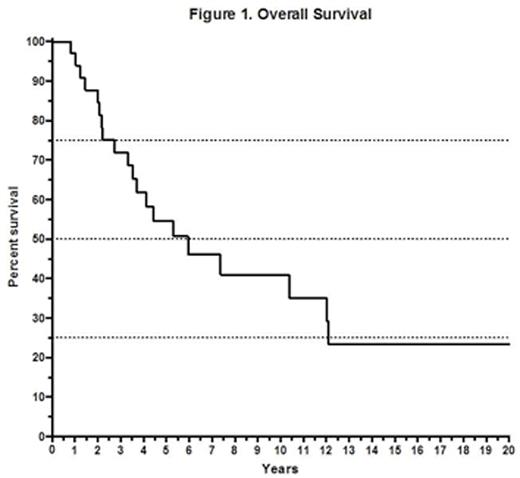Abstract
Introduction
The use of allogeneic stem cell transplantation (Allo-SCT) in patients with multiple myeloma (MM) remains controversial, but it offers prolonged disease free survival in some patients. It is unclear which patients should undergo Allo-SCT, what conditioning regimen should be used, and what the timing of the transplant should be in the course of the disease. Therefore, we sought to contribute our center's experience to the growing body of literature.
Methods
We performed a retrospective observational cohort study of all patients who underwent Allo-SCT for multiple myeloma at our center between January 1, 1992 and May 31, 2016. Categorical variables were compared using Pearson's chi-square test and the Kaplan-Meier method was used for the overall survival curves.
Results
Thirty-four patients underwent Allo-SCT for multiple myeloma and were included in this analysis. The median age was 40 years and 21 (62%) were male. Nineteen patients (56%) underwent Allo-SCT as upfront therapy, 1 (3%) underwent tandem autologous stem cell transplant (auto-SCT) followed by Allo-SCT, and 14 (41%) had salvage Allo-SCT at the time of relapse. Twenty-four (70.5%) patients had a matched related donor, 1 (3%) had a mis-matched related donor, 8 (23.5%) had matched unrelated donor and matching in 1 (3%) was not available. Myeloablative conditioning was given in 18 patients (52.9%) and non-myeloablative conditioning in 13 (38.2%) with 3 (8.8%) missing. The conditioning regimens included: 5 (15%) Flu-Mel, 7(20.6%) Flu-Bu, 13 (38%) Bu-Cy ± TBI, 6 (17.6%) MelVPTBI, and 3 (8.8%) were missing. Median overall survival (OS) for all patients was 72.5 months from diagnosis (figure 1) and 26.5 months from the time of Allo-SCT. For the 19 patients who had upfront Allo-SCT, median OS from diagnosis was 7.4 years compared to 5.3 years for those having salvage Allo-SCT (figure 2). However, in the upfront group 6 (32%) were alive 10 years post Allo-SCT and the survival curve reaches plateau, whereas in the salvage group, no patient was alive after 8 years post Allo-SCT. There was no difference in median survival between myeloablative and non myeloablative conditioning (2.9 versus 1.33 years, p=0.925). There have been 20 deaths in our cohort (59%); 5 (14.7%) from transplant related mortality within 1 year, 9 (26.5%) from disease progression, and 6 (17.6%) transplanted remotely whose cause of death is unknown.
Conclusions
Our data suggest that Allo-SCT offers prolonged disease free survival in some patients. In our small cohort, a greater proportion of patients undergoing upfront Allo-SCT achieved long term survival, raising the possibility that this group of patients may benefit more from Allo-SCT. Further prospective studies are needed to clarify the role of Allo-SCT in MM.
Kew:Celgene: Honoraria. McCurdy:Celgene: Honoraria.
Author notes
Asterisk with author names denotes non-ASH members.



This feature is available to Subscribers Only
Sign In or Create an Account Close Modal